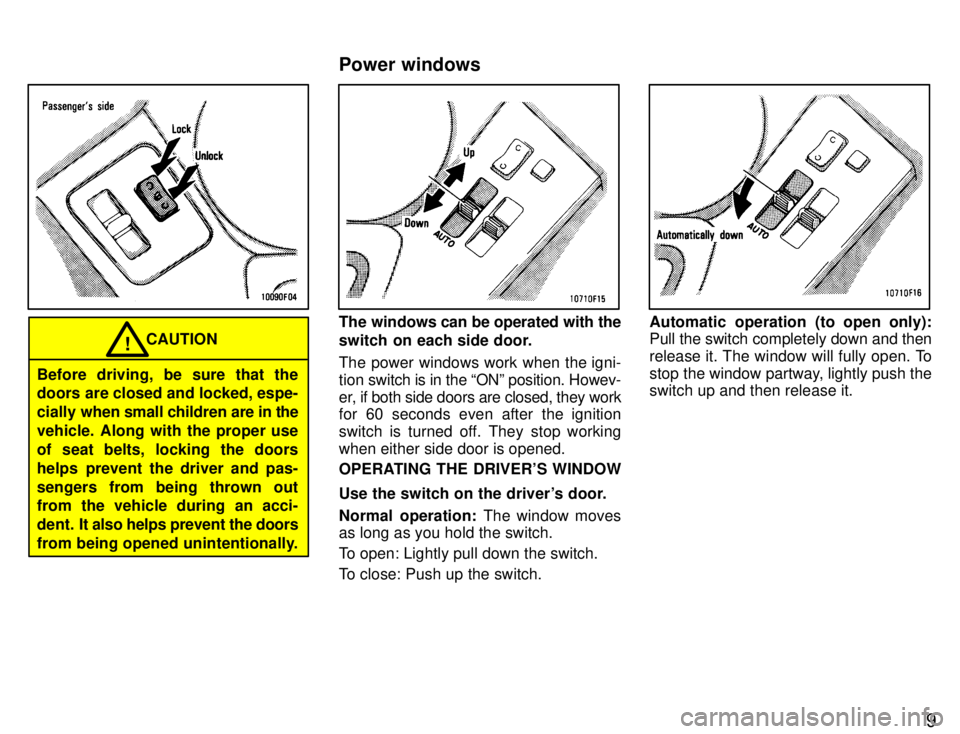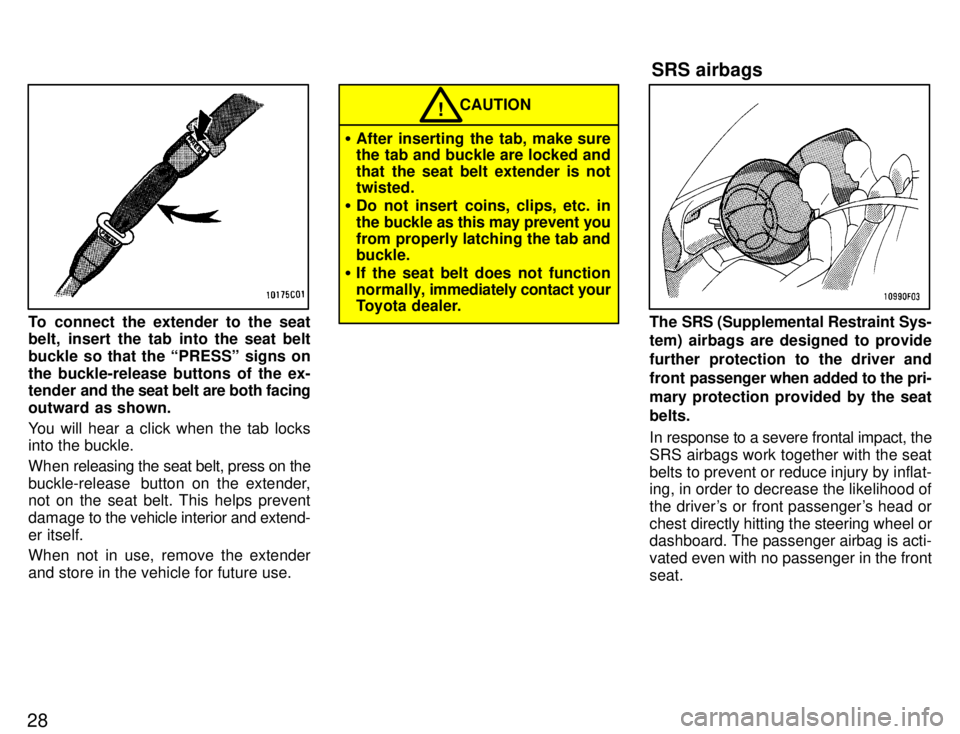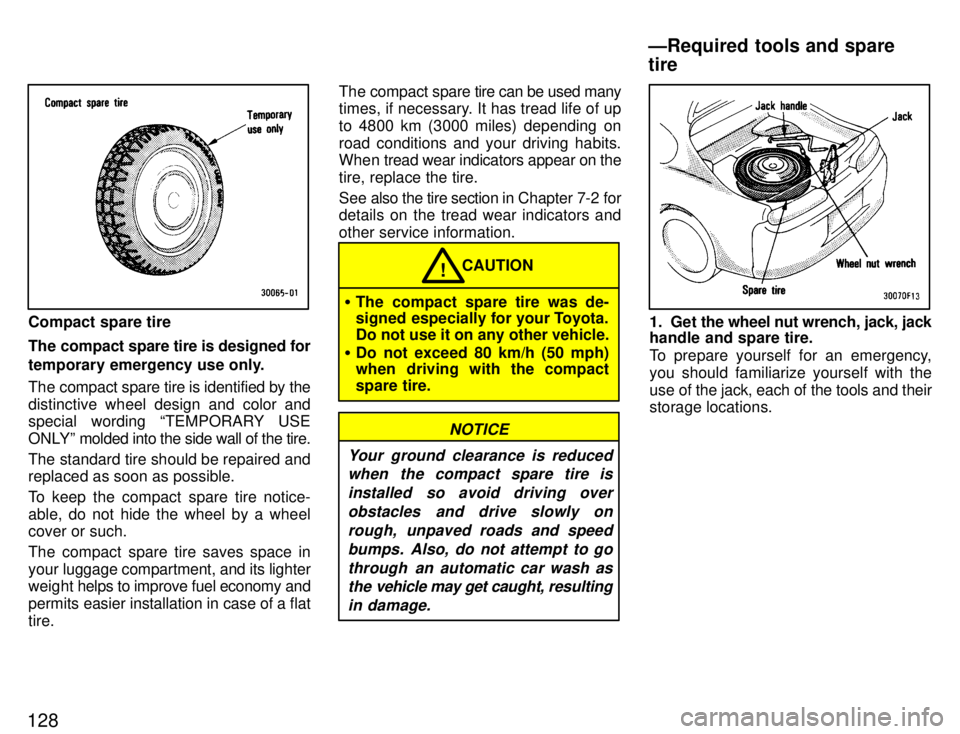1996 TOYOTA SUPRA ESP
[x] Cancel search: ESPPage 10 of 188

9
CAUTION!
Before driving, be sure that the
doors are closed and locked, espe-
cially when small children are in the
vehicle. Along with the proper use
of seat belts, locking the doors
helps prevent the driver and pas-
sengers from being thrown out
from the vehicle during an acci-
dent. It also helps prevent the doors
from being opened unintentionally.
The windows can be operated with the
switch on each side door.
The power windows work when the igni- tion switch is in the ONº position. Howev-
er, if both side doors are closed, they work
for 60 seconds even after the ignition
switch is turned off. They stop working
when either side door is opened.
OPERATING THE DRIVER'S WINDOW
Use the switch on the driver's door.
Normal operation: The window moves
as long as you hold the switch.
To open: Lightly pull down the switch.
To close: Push up the switch.Automatic operation (to open only):
Pull the switch completely down and then
release it. The window will fully open. To
stop the window partway, lightly push the switch up and then release it.
Power windows
Page 11 of 188

10
OPERATING THE PASSENGER'S WIN-
DOW
Use the switch on the passenger's
door. The driver's door also has a
switch that controls the passenger's
window.
The window moves as long as you hold the switch.
To open: Pull down the switch.
To close: Push up the switch.
If you push in the window lock button on
the driver's door, the passenger's window cannot be operated.
CAUTION!
To avoid serious personal injury,
you must do the following. � Always make sure the head,
hands and other parts of the
body of all occupants are kept
completely inside the vehicle be-
fore you close the power win-
dows. If someone's neck, head or
hands gets caught in a closing
window, it could result in a seri-
ous injury. When anyone closes
the power windows, be sure that
they operate the windows safely.
� When small children are in the ve-
hicle, never let them use the pow-
er window switches without su-
pervision. Use the window lock
button to prevent them from mak-
ing unexpected use of the switches.
� Never leave small children alone
in the vehicle, especially with the
ignition key still inserted. They
could use the power window
switches and get trapped in a
window. Unattended children
can become involved in serious accidents.
Page 29 of 188

28
To connect the extender to the seat
belt, insert the tab into the seat belt
buckle so that the PRESSº signs onthe buckle-release buttons of the ex-
tender and the seat belt are both facing
outward as shown.
You will hear a click when the tab locks into the buckle.
When releasing the seat belt, press on the
buckle-release button on the extender, not on the seat belt. This helps prevent
damage to the vehicle interior and extend-er itself.
When not in use, remove the extender
and store in the vehicle for future use.
� After inserting the tab, make sure
the tab and buckle are locked and
that the seat belt extender is not twisted.
� Do not insert coins, clips, etc. in
the buckle as this may prevent you
from properly latching the tab and buckle.
� If the seat belt does not function
normally, i mmediately contact your
Toyota dealer.
CAUTION!
The SRS (Supplemental Restraint Sys-
tem) airbags are designed to provide
further protection to the driver and
front passenger when added to the pri-
mary protection provided by the seatbelts.
In response to a severe frontal impact, the
SRS airbags work together with the seatbelts to prevent or reduce injury by inflat- ing, in order to decrease the likelihood of
the driver's or front passenger's head or
chest directly hitting the steering wheel or dashboard. The passenger airbag is acti- vated even with no passenger in the frontseat. SRS airbags
Page 30 of 188

29
This indicator comes on when the
ignition key is turned to the ACCº or
ONº position. It goes off after about 6
seconds. This means the SRS airbags
are operating properly.
The SRS airbag warning light system
monitors the front airbag sensors, center
airbag sensor assembly, inflators, warn-
ing light, interconnecting wiring and power sources.The SRS airbag system is designed to
activate in response to a severe frontal
impact within the shaded area be-
tween the arrows in the illustration.
The SRS airbags will deploy if the severity
of the impact is above the designed
threshold level, comparable to an approxi-
mate 20 km/h (14 mph) collision when im-
pacting straight into a fixed barrier that
does not move or deform.
If the severity of the impact is below the
above threshold level, the SRS airbags
may not deploy. However, this threshold velocity will be
considerably higher if the vehicle strikes
an object, such as a parked vehicle or sign
pole, which can move or deform on im-
pact, or if it is
involved in an underride col-
lision (a collision in which the nose of the
vehicle underridesº, or goes under, the
bed of a truck). It is possible with collision severity at the marginal level of airbag sensor detection
and activation that only one of your ve-
hicle's two airbags will deploy.
For your safety, be sure to always wear your seat belts.
Page 50 of 188

48Make sure you turn the defoggers off
when the surfaces are clear. Leaving the
defoggers on for a long time could cause
the battery to discharge, especially during
stop-and-go driving. The defoggers are not designed for drying rain water or for
melting snow.
If the outside rear view mirrors are heavily coated with ice, use a spray de-icer be-
fore operating the switch.
NOTICE
When cleaning the inside of the rear window, be careful not to
scratch or damage the heater wires.
Page 67 of 188

Part 1Car audio system operating tips
65
OPERATION OF INSTRUMENTS AND CONTROLSÐ
Chapter 1-7 Car audio system and Air conditioning system �
Car audio system operating tips
�AM-FM radio with electronic tuner and cassette tape player
�AM-FM radio with electronic
tuner, cassette tape player and Compact Disc player
�Automatic air conditioning controls
�Dashboard vents
�Lower vent
You can listen to the car audio system
when the ignition key is at ONº or
ACCº. However, if the engine is not
running,
the key must be in the ACCº
position.
ILLUMINATION CONTROL LOGIC When the instrument panel lights are on,
the letters on operable buttons of the
mode in current use light up. On some au-
dio-units, the mode selection and eject
buttons also light up.
On some audio-units, when a cassette tape is not in the slot, the letters on the tape mode buttons do not light up, but the
slot lights up for easy access. Once a cas-
sette tape is inserted, the letters on the
tape mode buttons light up, and the slot
stops illuminating. RADIO FM reception tips
Most of us are not aware that a vehicle is
not an ideal place to listen to a radio. Be- cause it moves, reception conditions
change continuously. Buildings, terrain,
signal distance and noise from other ve-
hicles are all working against good recep-
tion. Some FM reception conditions may appear to be problems even though they are normal.
The following characteristics are normal
for a given reception area, and they do not
indicate any problem with the radio itself. �
Fading and Drifting: On the average,
the broadcast range of FM stations is limited to about 40 km (25 miles), ex-cept for some high power stations.
If a vehicle is moving away from the
desired station's transmitter, the signal
will tend to fade and/or drift. This phe-
nomenon is more noticeable with FM
than with AM, and is accompanied by distortion.
Fading and drifting can be minimized
to a certain degree by fine tuning, or
you should tune in to a stronger signal.
� Static and Fluttering: When the line-
of-sight path between a transmitter
and vehicle is blocked by large build-
ings or the like, static or fluttering may
occur because of the characteristic of
FM. In a similar effect, a fluttering
noise is sometimes heard when driv-
ing along a tree-lined road.
This static and fluttering can be re-
duced by adjusting the tone control for
greater bass response until the distur-
bance has passed.
Page 92 of 188

90The radio has two FM selections, FM1º
and FM2º. You can preset any desired six
stations in each selection. W
hen you pre-
set an FM station, check which selection you have used.
2. Tune in the desired station. (See (b)
Selecting a stationº.)
3. Push one of the station selector but-
tons and hold it until a beep is heard. This
sets the station to the button and the but-
ton number will appear on the display.
To change the preset station to a dif ferent
one, follow the same procedure.
The preset station will be cancelled when
the power source is severed (battery dis-connected, burnt fuse, etc.). (d) Adjusting the tone Automatic tone adjustment Push the EQº button repeatedly until the
desired frequency response pattern ap-
pears on the display. This function auto-matically controls the tone in accordance with the selected pattern.
To change the preset mode, adjust the manual tone control knobs as you like. (See the following Manual tone adjust- mentº.) To memorize the setting you have se-
lected, push the EQº button for 2 sec-
onds until a beep is heard. To cancel the
memory,
push the EQº button for 10 sec-
onds until the second beep is heard.
To cancel all the memory which you have
set, push the EQº button for 20 seconds until the third beep is heard. Manual tone adjustment
Before using the tone controls, push the
EQº button repeatedly until your desired
response pattern appears on the display.
To adjust a low-pitched tone, push the
BASSº knob (if pushed in) and turn it. At the time, the BASSº display will change.
To adjust a middle-pitched tone, push the
MID BALº knob (if pushed in) and turn it.
At the time, the MIDº display will change.
To adjust a high-pitched tone, push the
TREB FADEº knob (if pushed in), and
turn it. At the time, the TREBº display will
change. (e) Adjusting the sound balance
To balance the sound between the right
and left speakers, push the MID BALº knob (if pushed in), pull it fully out and turn it.
To balance the sound between the front
and rear speakers, push the TREB
FADEº knob (if pushed in), pull it fully outand turn it. (f) Listening to the cassette tape
1. Put the cassette into the slot, with the
tape side to the right and lightly push it in.The tape player will grab the cassette and
slide it into place to play it. If the radio or
Compact Disc
player is on when inserting
the cassette, it will automatically turn off.
If the cassette is already in the slot, push
the TAPEº button.
At this time, PLAYº will appear on the dis-
play.
The tape player can also be turned on by
pushing the PWR VOLº knob if the tape
player was playing when the system was
turned off by pushing the knob. When a metal or chrome equivalent tape
is inserted, the player will automatically
adapt to it and MTLº will appear on the
display.
2. If using a tape recorded with Dolby
NR*, push the button by the double-D
symbol to select the Dolby B NR or Dolby
C NR mode. The display will indicate
which Dolby noise reduction system is op-
erating. The Dolby B NR mode reduces tape noise by about 10 dB. The Dolby C NR mode re-duces tape noise by another 10 dB, or
about 20 dB total. For best sound repro-
duction, select the same NR mode that was used to record the tape.
Page 130 of 188

128
Compact spare tire
The compact spare tire is designed for
temporary emergency use only.
The compact spare tire is identified by the
distinctive wheel design and color and
special wording TEMPORARY USE
ONLYº molded into the side wall of the tire.
The standard tire should be repaired and replaced as soon as possible.
To keep the compact spare tire notice-
able, do not hide the wheel by a wheel cover or such.
The compact spare tire saves space in your luggage compartment, and its lighter
weight helps to i mprove fuel economy and
permits easier installation in case of a flattire. The compact spare
tire can be used many
times, if necessary. It has tread life of up
to 4800 km (3000 miles) depending on
road conditions and your driving habits.
When tread wear indicators appear on the
tire, replace the tire.
See also the tire section in Chapter 7-2 for
details on the tread wear indicators and other service information.
� The compact spare tire was de-
signed especially for your Toyota. Do not use it on any other vehicle.
� Do not exceed 80 km/h (50 mph)
when driving with the compact spare tire. CAUTION
!
NOTICE
Your ground clearance is reduced when the compact spare tire is
installed so avoid driving overobstacles and drive slowly on rough, unpaved roads and speedbumps. Also, do not attempt to go through an automatic car wash asthe vehicle may get caught, resulting
in damage.
1. Get the wheel nut wrench, jack, jack
handle and spare tire.
To prepare yourself for an emergency, you should familiarize yourself with the
use of the jack, each of the tools and their storage locations.
ÐRequired tools and spare tire